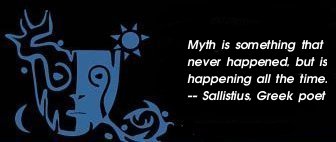|

Sacrifice and Scapegoating in America
© 2007 by Barry Spector
[Image: The Scapegoat by William Holman Hunt]
... we hear a screech of brakes and a crash... Cold chills go up and down our spine; we say "How awful!" — and run outside to see the accident. This is poor-quality Dionysus... what happens to a basic human drive that has not been lived out for nearly four thousand years.
— Robert Johnson
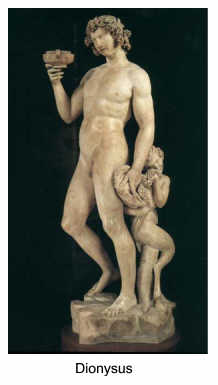 Carl Jung told us that the ancient gods didn't die; they went underground and resurfaced as illness in the body, the body politic, and the soul of the world. Carl Jung told us that the ancient gods didn't die; they went underground and resurfaced as illness in the body, the body politic, and the soul of the world.
The stories that Americans tell ourselves about ourselves maximize individualism, conflict, and competition while minimizing aesthetic, sensual, and ecological relationships. Centuries of literal thinking have left us without the mythic and ritual tools to comprehend the tragedy, the mystery, and the ambiguity of existence. And the unprecedented rate of technological and cultural change has put such pressure on the collective consciousness that millions have opted for increasingly simplistic answers that might prolong our characteristically American flirtation with innocence.
Awakening from this fantasy requires that we fully comprehend how much we have lost, how much our imagination has been diminished. We have settled for the minimum, the "toxic mimic" of the real thing, allowing Dionysus and the other divinities into American life in ways that keep us barely alive yet hungry for real nutrition. Like the villain Tantalos confined forever in Hades, we are tantalized, dimly perceiving the soul's food — almost within reach — but we have allowed our eating skills to atrophy.
We unconsciously manifest and honor the god in many styles of what Robert Johnson calls "poor-quality Dionysus." They are the ways he squeezes through the walls and slowly widens the fissures, leading either toward healing or toward collapse, but they are hard to perceive because of their sheer commonality, like myth itself. We rarely notice how we unconsciously attempt to recover our ancient relationship to the gods. But this is how he works. As Rafael Lopez-Pedraza writes, "Dionysus always appears in a distorted form... it is part of his nature."
This god often appears in the modern world as the scapegoat, that part of ourselves that we sacrifice in order to maintain a consistent story of who we are. In America, this means innocence; and innocence requires a population of those we can label as guilty.
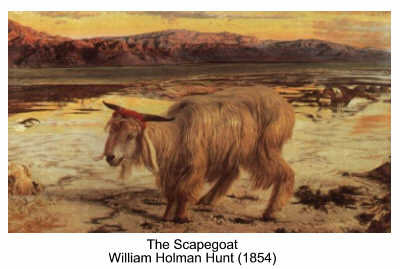
The Hebrews atoned for their sins by killing and burning a goat, whose blood placated Jehovah. They loaded those sins onto a second goat, which they dedicated to Azazel, a Semitic goat-god who embodied primal creativity and sexual potency. They then sent it into the wilderness; symbolically, they sent its unruly, Dionysian energies back to their origin in the unconscious.
Similarly, Athens occasionally expelled a man to purify the city. The victim (pharmakos) was both the poison and its antidote, just as Dionysus was both cause of and cure for madness. But Pagans also renewed themselves through periodic festivals of ecstatic license and sacred marriage. They ritually killed a kid representing Dionysus, cut it into pieces and stewed it in its mother's milk. Johnson writes that "Psychologically, they took the irrational, jumpy quality symbolized by the goat and killed it, returning it to the underworld." Then they ate it as a kind of communion, safely re-incorporating those energies. The Hebrews, by contrast, forbade this custom.
Similar customs are found everywhere: animals were loaded with the sins (or unacceptable desires) of the community and sent away; boats were released into the ocean. In countless examples of human scapegoating, communities chose certain men to act the part of death, sickness or the dying god himself. The people symbolically — or literally — killed or exiled these men, expecting them to take the pollution with them. The Christian mass reenacts the sacrificial murder of Jesus to play out its central theme of redemption. European secular culture kept the idea alive in the carnivals of the Middle Ages, crowning a "king of fools" who reigned over the wild proceedings.
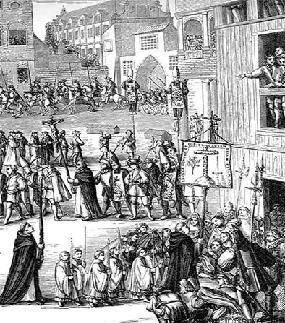 These are examples from times when vestiges of the indigenous, creative imagination survived. But the breakdown of the mythic world was nearly complete by the Renaissance. With scientific advances and Protestant rebellion questioning Papal authority, darker forms of scapegoating evolved. The Inquisition's "test of faith" was an elaborate ritual of murder, purification and warning. Conquistadores and Puritans brought this tradition to America. These are examples from times when vestiges of the indigenous, creative imagination survived. But the breakdown of the mythic world was nearly complete by the Renaissance. With scientific advances and Protestant rebellion questioning Papal authority, darker forms of scapegoating evolved. The Inquisition's "test of faith" was an elaborate ritual of murder, purification and warning. Conquistadores and Puritans brought this tradition to America.
Their ritual components included consecrated places; fire, symbolizing the deity; and a sacred tree where the sacrifice was performed. "The victim," writes sociologist Orlando Patterson, "mediated between the sacred and the profane." Society needed scapegoats to resolve fundamental social transitions, such as that faced by the American South after the Civil War. There, sacrificial rituals — lynchings — were performed well into the 1930's.
René Girard argues that every community develops rituals to protect its members from their own violence, identifying a victim whose death will cure everyone. He is truly a "healing drug" because once the community has identified him as the source of the trouble, then they can rid themselves of the pollution: "... any community that has fallen prey to violence or has been stricken by some overwhelming catastrophe hurls itself blindly into the search for a scapegoat." They achieve temporary unity by projecting their shadows upon the Other — often identified as having the Dionysian qualities of sexuality or irrational violence — where all can safely view them. However, the need to be cleansed of the unacceptable feelings always builds up again. Scapegoating is a temporary fix leading to addictive repetition.
It often involves accusations of mythic crimes such as incest and especially, the killing of the children. Romans accused early Christians of eating children. Once in power, Christians did the same to persecute pagans and Jews. Twelve hundred years later, as many French women were executed for infanticide as for witchcraft.
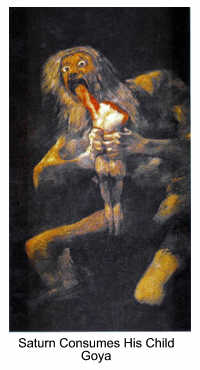 Infanticide makes us reconsider our fundamental images of fathering. Uranos abandons the children, while Cronos consumes them. Abraham would murder Isaac to prove himself before Yahweh, who sacrifices his own son Jesus. They literalize initiation, teaching us that when we forget the need to symbolically kill the child, we find actual ways to do so. Infanticide makes us reconsider our fundamental images of fathering. Uranos abandons the children, while Cronos consumes them. Abraham would murder Isaac to prove himself before Yahweh, who sacrifices his own son Jesus. They literalize initiation, teaching us that when we forget the need to symbolically kill the child, we find actual ways to do so.
Modern culture socializes children by replacing their sense of primordial unity with the polarities of black/white, male/female, good/evil, etc. But this process — begun in original sin — has left a sense of guilt and sorrow deep in the recesses of the western psyche. In response, the collective unconscious has dreamed up the mythic images of the killing of the children, projecting them onto scapegoats who, in their righteous suffering, might cleanse us.
The killing of the children is a fundamental statement of patriarchy and the universal substrate for scapegoating in America, where we sacrifice our children through negligence, poverty — and rape. Thirty percent of rapes are of girls eleven years old or younger. America, virtually alone in the world, executes non-adults. A quarter of our children live in poverty.
But aren't adolescents troublemakers? Sociologist Mike Males reports that they commit only thirteen percent of violent crimes, and that aging baby boomers (most of whom are white) are responsible for most drug addiction and crime. Even so, many states prosecute children as young as ten as if they were adults, and sixty percent of adults favor executing teenage killers.
We reduce many social problems to the mythically-charged war against the children, especially when we substitute the code word, "teenage," for "black" or "Latino." This assault yields stunning numbers. Youths consistently receive prison sentences sixty percent longer than adults for the same crimes. When adults are victims of sex crimes, sentences are tougher than when the victims are children; and parents who abuse their children receive shorter sentences than strangers who do so.
We further scapegoat our children with the cruel euphemism of "no child left behind." Government imposes narrow agendas, overrules local control, punishes entire schools (by withdrawing funding) for the failures of the few, and completely ignores poverty's impact on learning. Forty percent of elementary schools have either eliminated recess or are considering reducing it, to allow more time to prepare for testing.
Where does the anger go in a culture that eats its own children? We periodically identify persons whose mere existence calls our identity, especially our notions of gender, into question — and label them as child-murderers. This relieves us of the "terror of history," says historian Teofilo Ruiz: "... at the very root of our making into civilized people lies always the fact of child sacrifice." Having raised individualism to mythic status, we stigmatize individuals — priests or single men — as child molesters rather than addressing unemployment, overcrowded schools and a culture of violence. Men can no longer work in early education without investigations into their moral purity. So many have left the field that only one in five public teachers (one of eleven elementary teachers) are men.
Fundamentalists dismiss AIDS as a gay disease, God's judgment on secular society. Psychologist Judith Savage laments, "The victims of the disease become the disease... they are AIDS." Ironically, increasing visibility has led to new scapegoating. Gays comprise thirty percent of completed youth suicides.
The crisis of the disintegrating nuclear family has made young women into scapegoats. In many "red" states a girl who has been raped by relatives cannot obtain access to abortion or non-religious counseling. Her family can force her to have the child, only to ostracize her. She might run away with the baby to escape the ongoing abuse, go on welfare until the funds run out, and end up a homeless prostitute. She would be a sacrificial victim, no different from girls in Afghanistan.
The "welfare queen" carries the legacy of a legal system that equated promiscuity with dishonesty. As recently as the 1970s, courts often refused to trust the testimony of such women. Economic decline and (hetero) family disintegration lay the ground for the resurgence of intolerance. Gay marriage is now the primary Republican "values" issue. Prior to that, we have seen panics over demonic abuse, alien abduction and poisoned Halloween candy.
But for centuries a pattern of scapegoating existed that remains uniquely and horrifyingly American — the violent sacrifice of the black Other. The most energetic accusations have been of sexual relations between the races — our richest, if saddest, example of "poor-quality Dionysus." Sociologist Calvin Hernton wrote that the image of the black sexual beast in the racist mind was so extreme that he had to eradicate it, yet so powerful that he worshipped it:
In taking the Black man's genitals, the hooded men...are amputating that portion of themselves which they secretly consider vile, filthy, and most of all, inadequate...hop(ing) to acquire the grotesque powers they have assigned to the Negro phallus, which they symbolically extol by...destroying it.
Clearly, racial violence kept — and keeps — poor blacks and whites from uniting. For generations, the threat of lynching kept both black men and white women in their places. Patterson, however, asks that we look more deeply, arguing that of nearly five thousand lynchings between 1880 and 1930, some forty percent were human sacrifices.
Not spontaneous mob-violence, lynching was carefully orchestrated. Participants came from all social classes, and clergymen often presided. A favorite day for lynching was Sunday. The site, chosen in advance and advertised in newspapers, was usually a tree in the center of the community. Trees were sacred not only in Pagan heritage, but specifically to Christianity: both Adam's fall and Christ's death, the two most important events in Christian cosmology, were associated with tree-symbols. The religion was founded upon a single human sacrifice. All threats to white supremacy, wrote theologian James Sellers, took on mythic importance:
Segregation is a system of belief that would protect its devotees from..."the powers of death and destruction"...It therefore becomes a holy path, complete with commandments, priests, theologians...
Lynchings were not quick "tree-hangings." If they couldn't apprehend the accused, the mob randomly selected a kinsman. Often, he was tortured for hours before being burnt at the stake. They distributed his remains like religious relics, for his death — and, like Dionysus, his dismemberment — cleansed and unified the community.
To a society obsessed with both violence and sin, the ex-slave symbolized both. He was "obviously" enslaved to the flesh, writes Patterson, and his blackness invited a fusion of racial and religious symbolism: "Afro-Americans became to the body politic what Satan was to the individual and collective soul...metaphor of a "black" malignancy." Excising it was the religion's central ritual. Reading of this brutality, we recall the crazed ferocity of Agave and her sisters as they dismember Pentheus in Euripides' Bacchae:
...shrieking in triumph. One tore off an arm, another a foot... ribs were clawed clean of flesh and every hand was smeared with blood...
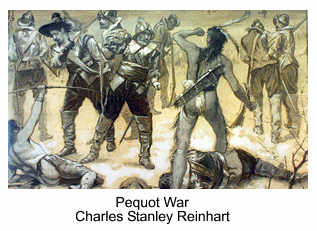 We recall the delight in detailed imagery taken by such worthies as Tertullian, Jonathan Edwards and the chronicler of the 1636 Puritan massacre of the Pequot Indians: We recall the delight in detailed imagery taken by such worthies as Tertullian, Jonathan Edwards and the chronicler of the 1636 Puritan massacre of the Pequot Indians:
...see them thus frying...and the streams of blood quenching the same, and horrible was the stincke and sente there of, but the victory seemed a sweete sacrifice, and they gave the prays thereof to God...
This is neither rare nor irrational. Hatred — and joy — of this intensity is an essential component of a world-view that has abstraction and alienation at its core and innocence as its mask. It requires ritual sacrifice to allow its practitioners to maintain a consistent moral image. It enabled the My Lai massacre — and dozens like it — in Vietnam, and in Iraq. It allows us to ignore photos of torture.
Mob behavior could take on mythic familiarity. In 1899, 10,000 Texans paraded their victim on a carnival float, like the king of fools, or Dionysus in Athens' Anthesteria festival — or Christ at Calvary. Patterson writes, "...the burning cross distilled it all: sacrificed Negro joined by the torch with sacrificed Christ, burnt together and discarded."
Approaching Dionysus forces us to encounter the potentials for horror as well as ecstasy that lie within us. We must know who we have been if we are to imagine what we might someday be; the ghosts of the past require this. The communal sacrifice of lynching has finally disappeared. But whites attacked dozens of "Arab-looking" persons, murdering several after 9/11. Nearly alone, America preserves capital punishment, and eighty percent of its victims are minorities. Although a hundred Death Row inmates have been exonerated since 1976, public opinion hasn't changed. Without deterrent value, the only motivation for support is the old vengeance of the father-gods. Patterson concludes, "Today we no longer lynch in public rituals supervised by local clergymen. Instead, the state hires the hangman to do it."
Now we search for subtler means, in what Aaron Kipnis calls "our culture's desperate attempt to quarantine its shadow." America imprisons more citizens, over forty percent of them men of color, than any other country, with five times as many prisoners as we had in 1980. Ten percent of black men in their 20's live behind bars, and twenty-five percent can expect imprisonment sometime. The myth of American innocence requires that whites perceive young blacks as inherently, irredeemably violent. When minorities show they can rise above the conditions imposed upon them, the state intervenes: Los Angeles youth gangs have carefully crafted truces, but local police have repeatedly sabotaged them.
Scapegoating of blacks always proceeds in cycles of collusion between government and media. In 2005, we witnessed the cycle condensed into a single week in New Orleans:
- Stage One is universal neglect and overt racism. After the storm, FEMA's refusal of help led to scenes of degradation in the Superdome.
- Stage Two: TV emphasized anarchy and crime over cooperation, showing whites "finding food," while blacks were "looting." Barbara Bush and televangelists offered their racist commentaries, reinforcing stereotypes.
- Stage Three evolved. In the old fear of madness at the gates, suburbs refused entry to the "refugees." Police neglected rescue duty to protect private property. With 500,000 blacks homeless and invisible, conditions were set for the return to Stage One, further federal neglect.
America has found countless scapegoats, but why are we periodically compelled to lynch only one of them? Our myths remain polarized along racial lines: civilized vs. primitive, abstinence vs. promiscuity and sobriety vs. intoxication, all forming the opposition between composure and impulsivity. Similar percentages of whites and blacks engage in sex, drugs and violence, yet whites are privileged to assume that blacks are more susceptible to such "vices."
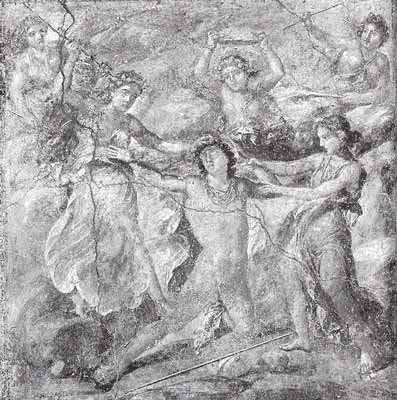 The black man is "American Dionysus." This image is rooted in the enigmatic outsider of The Bacchae. He may appear effeminate; or he may tremble with the potential violence of one who has nothing to lose. Despite the superficial veneer of misogynistic Hip-Hop lyrics, he has come from beyond the gates to liberate the women, leading them to the mountains to dance among themselves, free of patriarchal control. The black man is "American Dionysus." This image is rooted in the enigmatic outsider of The Bacchae. He may appear effeminate; or he may tremble with the potential violence of one who has nothing to lose. Despite the superficial veneer of misogynistic Hip-Hop lyrics, he has come from beyond the gates to liberate the women, leading them to the mountains to dance among themselves, free of patriarchal control.
America elevates the dry, masculine, Apollonian virtues of spirit over the wet, feminine and Dionysian. Post-war blacks used soul to define their music and culture in contrast to these values. White youth understood the term instinctively. Patterson observes that in only a few generations our image of the Other has expanded to include aspects of which whites are now admittedly, nervously envious:
... the ultimate Dionysian symbol...the crosser of boundaries and the dissolver of those very boundaries...The Afro-American male body — as superathlete, as irresistible entertainer...as sexual outlaw, as gangster...
The cultural products of black athletes and entertainers have become a "Dionysian counterweight" unstably balanced with the discipline required of those who must tolerate the conditions of the workplace.
Dionysus (has) free reign of the inner cities...safely confined behind ghetto walls until the instinctual need for release from the Apollonian pressures...calls for its tethered, darkened presence.
Black entertainers provide the cultural container that allows white youth to act out some rebellion between their suburban school years and the corporate life most eventually submit to. Dionysus is temporarily imprisoned within the palace walls. This is not initiation, but merely a controlled transition into consumer lifestyles. All learn to project their innate grandiosity of soul onto celebrities. Instead of living creative lives as involved citizens, we consume the cultural products fed to us by the media. We watch the Dionysian experience, like Pentheus in his tree spying on the maenads.
Assuming that blacks have liberty to behave in ways the middle class usually represses, whites project both fear and envy. Some blacks play along, while others resent this role. When capitalism's tensions threaten to disrupt business, politicians rely on the Other to divert us. From the perspective of those who actually bear this burden, the unacknowledged subtext of most of our domestic issues is race.
THE STREETS
Is welfare a minority issue? A million African-American children live in "extreme poverty." But the typical welfare recipients are a thirty-year-old woman and her two children, forced there by divorce and abandoned by their unemployed father. Realistic estimates of poverty in America range from 40 to 80 million people, most of whom are white.
The mythic narrative ignores corporate welfare and the feminization of poverty. Since 1994, most white males have voted Republican, partially because of fear generated over affirmative action. Few address the racial dimensions of the issue and the degree to which even poor whites have privilege. Generosity of state welfare reform varies according to demography: those with overwhelmingly white populations have far stronger safety nets and have imposed far softer sanctions.
Talk-jocks rant about blacks picking up their food stamps in Cadillacs. Doesn't this image evoke Dionysus, with his entourage of frenzied women and satyrs, parading through town, spreading their "values" like Mardi Gras beads? Aren't they the essence of the sinful, fallen life to the puritanical mind — and aren't they tantalizing? What if all our self-control didn't guarantee redemption?
Immigrant bashing in America follows a familiar pattern. Since 1900 most newcomers have arrived from countries that lack both Northern European traditions of self-denial as well as WASP physical characteristics. Some won't grasp the sacred notion of delayed gratification. Many of them dance. Beyond simple economics, the anxiety stems from the Puritan fear of pollution.
What about crime? Oddly, we project onto blacks exactly what the heritage of discrimination ensures that they do not have — power. Lurid predictions in the 1990's warned of "superpredators" who killed for basketball shoes. In fact, blacks commit only a quarter of all violent crimes, and whites are far more likely to be assaulted by other whites. But the frenzy of prison construction and execution of minorities continues even as crime rates reach their lowest levels in thirty years — and as all but two of the thirty-five teenagers who shot up their schools were white.
The middle class — overworked and terrified of the streets — engaged in "cocooning." Renting DVD's and shopping online, many conceded urban space to the Other. Ten million Americans work at home and eight million live in gated communities. Countless whites stay in at night because, as in a dream, they fear the dark men with their dark desires. But though the streets are safer than a generation ago, many prefer to watch simplistic resolutions in urban crime dramas.
With men favoring buzz-cut hairstyles, homeless men are often the only people with the long hair and beards popular in more optimistic times. Many remind us of Vietnam. They are everywhere — 3.5 million Americans, two-fifths of them children — are homeless at some point in a given year. And so many are black. Hurrying to produce or consume for Apollo, we find Dionysus in their unembarrassed behavior. They make us feel: disgust, pity and guilt. Retreating into judgment, we conclude that their misery is their own fault, proof again of our state of grace. We ignore the signs that we are all, like motherless children, a long way from home.
Ignoring systemic causes, cities push them across arbitrary borders — into other cities, or in New York, into underground subway tubes, where some 5,000 people allegedly live. Like Zeus or Odin, we confine the Other to the underworld. The myths, however, speak of the price those gods pay — in fear and vigilance — because those below, like horror movie villains who refuse to die, always threaten to re-emerge.
THE BODY
 Even though states with the lowest welfare rates have the highest teen pregnancy rates, the charge that public assistance promotes single motherhood draws its energy from Puritan rage at the notion of pleasure without consequences. Like maenads, these women follow their god, at government expense. Even though states with the lowest welfare rates have the highest teen pregnancy rates, the charge that public assistance promotes single motherhood draws its energy from Puritan rage at the notion of pleasure without consequences. Like maenads, these women follow their god, at government expense.
Few ask, however, why many girls don't use contraception. Aren't they searching for initiation by creating new life? Whereas boys extend themselves toward danger, girls push the other edge, taking that risky energy inward. Sex education doesn't impact this longing. They expect to be perceived as women once they are capable of bearing children. Older women rarely welcome them into the adult ranks at first menstruation anymore. So girls turn to equally uninitiated men, especially those who enact the role of American Dionysus, to conduct their rites of passage.
By drawing women away from the confines of gender roles, Dionysus is an archetypal male image of female independence. This is the mythic source of the murderous rage directed against abortion. Abortion providers are, in effect, Dionysian figures who loosen the controls and liberate women. Extremists hate them enough to murder them. Utilizing images of aborted fetuses to justify their crusades, they project their own child-hatred. Men whose sense of control is the most tenuous are the worst misogynists. Susan Faludi writes that most early anti-abortion activists were males under age thirty-five who were earning less than their fathers had. They were being "eaten" by their fathers' economy, and they resented women's progress: "Sexual independence, not murder (of the unborn), may have been the feminists' greater crime."
Obsession with the unborn masks the truth that America has abandoned its living children. The educational system serves the purposes of the corporate state, writes teacher Greg Nixon: "... elimination of the many...and election of the chosen few who have become most successfully systematized." But when millions of youth reject schooling for the sham it is, they fall further into poverty and become scapegoats yet again. Forty percent of New York City's children are impoverished, and thirty million Americans, most of them children, are malnourished. These statistics resulted from deliberate policy. In the 1980's hunger declined everywhere, with two exceptions: sub-Saharan Africa and the U.S., where it increased by fifty percent, primarily due to cutbacks in welfare. Over 600,000 American children are physically abused and 300,000 are sexually abused yearly. Of children who are murdered, family members kill two-thirds.
We insulate the fantasy of national innocence by forcing suffering — and responsibility — upon the truly innocent. Puritanism's logic condemns millions of children because of the alleged laziness of their parents. "We" can be innocent and deserving only if we compel "them" — children, minorities and, especially the children of minorities, those who have been fathered by American Dionysus — to carry the burden. Most of their rage converts to shame because in America children learn in countless subtle ways that they are the source of their own suffering. None other than our "most famous theologian" — Jerry Falwell — preached, "This is America. If you're not a winner it's your own fault."
THE UNDERWORLD
Prisons are our scapegoat repositories. We jail more people than any other country. With five percent of the world's population, we have a quarter of its prisoners. Twelve percent of black males in their twenties are in jail. We are the only democracy that disenfranchises felons. Thus, 1,500,000 blacks (thirteen percent of black men) cannot vote. Partially because felons cannot work in dozens of professions, most return to prison. A half million Americans work full-time in corrections.
60,000 mental patients are in asylums, but 280,000 are incarcerated. Deinstitutionalization — without funding for health services — merely put them on the streets. Los Angeles' Jail, with fifteen percent of its 21,000 inmates (eighty percent jailed for non-violent drug offenses) diagnosed as mentally ill — 3,200 people — is America's largest mental institution.
The prison population justifies the prison-industrial complex and provides cheap labor for industries that function within those walls. Now, Pentheus has Dionysus secured within the palace towers, and Dionysus pays his own way.
THE OUTSIDE AGITATOR
American Dionysus has his counterpart on the outside. Whereas the Other as drug dealer tempts the children, the Other as terrorist will destroy the palace itself. Even though right-wing whites have perpetrated almost all terrorist incidents in America, fear of the outsider is stronger than ever, a fear that was nurtured through the creation of an image.
For decades conservatives labeled anyone who questioned American dominance or white supremacy as "outside agitators." This poetic Dionysian menace implies two assumptions about us. The first is innocence. Terrorism, quips Noam Chomsky, is "what others do to us."
The second is weakness. Just as youths "can't resist" drugs or sex, the polis can entertain only mild diversity of opinion. Communist influence would have prevented discrimination of right from wrong and destroyed the immune system with "agit-prop." This outsider refused to play fair, infecting our values through trickery, rather than through direct, "manly" confrontation. Pentheus would attack directly; Dionysus doesn't. Pentheus throws fastballs, while Dionysus throws curves.
And both of them, the terrorist and the drug dealer, provoke our curiosity for another reason: they are closer than the rest of us to death. In the psyche, death evokes initiation. The deniers of death, writes Luigi Zoja, may feel "envy of the initiate, of he...who has contact with another dimension... someone to whom a truth has been revealed."
PORNOGRAPHY
The porn debate doesn't break down into right-left polarities. Conservatives share their abhorrence of it with feminists like Andrea Dworkin, who called it "sexually explicit subordination of women." Susan Griffin writes, "Each sale of a pornographic image is a sadistic act which accomplishes the humiliation of all women."
Others disagree. Camille Paglia argues that the existence of the huge gay porn industry counters the argument that porn is by definition subordination of women. Wendy McElroy suggests a "value-neutral" definition: "the explicit artistic depiction of men and/or women as sexual beings." Janice Radway, insisting on women's right to their own fantasies, writes of romantic novels: "... if he is 'mad with desire,' rape reflects her power over him."
Porn is very big business with annual U.S. profits of three to six billion dollars. The industry employs 100,000 people. There are 15-20,000 adult bookstores in the country, and three million customers patronize 800 adult theaters weekly. Some argue that porn is the economic engine that actually drives the Internet. Since seventy percent of American men aged 18-34 visit porn sites, perhaps we need to ask why porn is so popular.
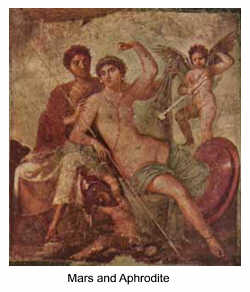 "Pink madness," says James Hillman, is the spell of obsession that the Goddess Aphrodite has cast over Western culture. Porn is the return of the repressed goddess who — denied access to our cultural consciousness — reappears in images. But the only way she can reach us is through fantasy. He defines porn as "lustful images, or imaginal lust" that appear when we don't have enough Aphrodite in our actual lives. One of her sons was Priapus — the grotesque character with the enormous erection — whose father was Dionysus. Hera cursed Aphrodite when she was pregnant. The misshapen child — and Puritanical hatred of porn — were the results. But so was our fascination with it. "Pink madness," says James Hillman, is the spell of obsession that the Goddess Aphrodite has cast over Western culture. Porn is the return of the repressed goddess who — denied access to our cultural consciousness — reappears in images. But the only way she can reach us is through fantasy. He defines porn as "lustful images, or imaginal lust" that appear when we don't have enough Aphrodite in our actual lives. One of her sons was Priapus — the grotesque character with the enormous erection — whose father was Dionysus. Hera cursed Aphrodite when she was pregnant. The misshapen child — and Puritanical hatred of porn — were the results. But so was our fascination with it.
Hillman sees this repression in the diminished "sensate quality of the world," loss of beauty: ugly buildings, tasteless tomatoes, talk radio. Consumerism, for all its marketing of sex and free choice, actually limits our modes of encountering the world to the economic and the therapeutic. It has banished the aesthetic; we live "an-aesthetized" lives.
Religions and scientists have condemned masturbation, presumably porn's goal. Doctors used female genital circumcision to cure or prevent "diseases" such as lesbianism. A 1959 urology textbook advised mechanical restraints to prevent masturbation. But the clues to the real issues are in Puritan fantasies. An 1889 crusader ranted against babysitters who allegedly allowed children to masturbate: "...the crime could hardly have been worse had the nurse...cut the throats of those innocent children..."
What are they so afraid of? Hillman answers: "The free-flow of fantasy images. We don't know where the fantasy might go." "John Jervis adds, "...sex represents the opposite of mastery of the body: an irrational subordination to the body..." Tribal societies rarely punish masturbation. They may set limits on behavior, but through their rich, polytheistic mythologies, they encourage the development of the inner, imaginative capacity. By contrast, patriarchal institutions from the Catholic Church to the Soviet state attempted to restrict all imagination — with the exception of the paranoid imagination.
But the more we control images, the more we are obsessed. In 1991 the Supreme Court closed a private club in Indiana that featured nude dancing. Antonin Scalia wrote:
... Indiana's nudity law would be violated...if 60,000 fully consenting adults crowded into the Hoosier Dome to display their genitals to one another, even if there were not an offended innocent in the crowd.
Would he be so disturbed if naked dancing didn't already exist in his head? Nobody prodded Scalia to think of that image. His imagination produced it. Texas senator John Cornyn argues, "It does not affect (you)...if your neighbor marries a box turtle. But that does not mean it is right..." Cornyn's imagination conjured inter-species marriage. Here is New Jersey's Rick Santorum:
If...you have a right to consensual sex within your home, then you have the right to bigamy...to polygamy... to incest...to adultery. You have the right to anything!.. That's not to pick on homosexuality. It's not, you know, man on child, man on dog...
Indeed. Pentheus, too, obsessed with the maenads, admits:
... if I climbed that towering fir that overhangs the banks, then I could see their shameless orgies better.
Puritans can't allow their hungers into awareness unless they oppose them and demonize others. Only then can they invite the Grand Inquisitor to kill parts of themselves.
Feminists are justifiably concerned about the objectification that leads people to tolerate violence. But researchers have never correlated porn viewing with violence. Hillman even suggests that its cathartic effects may well reduce the likelihood of acting out: "Suppose there aren't enough lustful images."
Aphrodite's son Eros married Psyche. The myth indicates that the soul (Psyche) cannot mature without the erotic imagination. Their daughter was Voluptos. Here is the alternative to the repression demanded by religion and capitalism: The end-result of soul-making is not asceticism but voluptuousness!
Denied knowledge of the Great Mother, however, we turn to her "toxic mimic," materialism. Associating Eros with consumer items, advertising inspires us with images of the unattainable, and has, therefore, a religious intensity. All literalists of both right (Christian or Muslim) or left (feminist or communist) assume no difference between fantasy and action; having "lust in one's heart," as Jimmy Carter confessed, is the same as enacting it. But the more we recognize the reality of the psyche, the less need we have for acting out; and the less need we have to project American Dionysus onto others.
DRUGS
The paranoid imagination has associated drugs with the dark Other ever since Chinese immigrants evoked opium hysteria. "Black cocaine fiends" of the early 1900's allegedly committed "seventy percent of all the crimes in Atlanta." Californians panicked in the 1930's over Latinos hooking children on marijuana. But the smokescreen points toward Dionysus, mysteriously appearing in the city, tempting the youth, playing upon their vulnerability. In 2002 Congress considered a bill to suppress the all-night dance parties, or raves, in which MDMA ("ecstasy") is the favorite drug. It was called the RAVE bill — "Reducing America's Vulnerability to Ecstasy."
Pot is considered a "gateway" to hard drugs, so government places it in the same risk category as heroin. But eighty percent of adults claim that drug abuse has never caused problems in their family. And teen drug deaths have fallen since their high point in the 1970's, while the rate of adult drug-related deaths has risen.
"Gateway," a powerful image, implies contamination by the Other. But blacks, thirteen percent of the population, comprise the same percentage of drug users and only sixteen percent of dealers, even though they suffer thirty-five percent of arrests and seventy-five percent of those jailed for drugs. Although blacks are twice as likely as whites to have their cars searched, police are twice as likely to find evidence of illegal activity in cars driven by whites. While whites over age thirty are thirty-six percent of California's population, they comprise sixty percent of its heavy drug users.
94 million Americans admit having turned on. This is no subculture of deviants: certainly well over half of adults. Despite the crusades, seventy-two percent favor decriminalization of pot, while forty percent favor legalization. Ten percent have used psychedelics. Two percent tried heroin.
The Old Right of the opportunists, with its libertarian contempt for state intervention in private life conflicts with the Religious Right and its much older war on the imagination. But the two Rights literally make a wrong, resolving their differences by heightening fear. Consequently, while only one-fifth of pot smokers regret having done so, seventy-four percent (including ninety-four percent of parents) would disapprove if their own children did.
Then there are the millions who use legal anti-depressants, those who consume alcohol in dangerous quantities and the six million who use prescription drugs non-medically. 15,000 doctors sell prescriptions to addicts, yet less than one percent of the War on Drugs addresses abuse of legal drugs.
What does that crusade cost? Federal spending on the War On Drugs is twenty billion/year, and local governments spend an additional twenty billion. There are 1.6 million arrests/year, half for pot (650,000 merely for possession), thirteen million arrests over twenty years. We spend $7.6 billion/year on marijuana enforcement, but pot use has not declined. Meanwhile, arrests for cocaine and heroin have sharply declined, while tobacco kills 1,000 Americans/day. Marijuana is our fourth most lucrative crop.
With so many happily turning on, why do we tolerate this costly and lethal crusade? The drug trade is so lucrative precisely because the products are illegal and, hence, relatively scarce. And the crusade itself is very big business. While Dionysus (Lusios, the Loosener) in other forms runs free, protected by the alcohol and tobacco lobbies, the feds continue to prosecute providers of medical marijuana. Males argues that they persist so fanatically because " it changes the image of who smokes pot from rebellious teens to respectable, suffering old folks."
Official culture ignores demand and concentrates billions on supply. Pentheus's thugs zealously patrol the boundaries of the realm to prevent the flow of that which is illegal (and highly desirable). Meanwhile, popular culture — MTV — displays prolific images of our own Bacchantes dancing drunkenly on spring break in Fort Lauderdale.
Most baby boomers engage in mild intoxication, but penalties have increased greatly. The end of the Cold War required new scapegoats. Soon, growing pot could result in life sentences. Supreme Court cases dealing specifically with marijuana led to huge increases in government power long before the Patriot Act. But almost all drug-related criminal activity occurs because the drugs are illegal, not as a result of their effects. How curious, writes Michael Ventura: "...creating conditions of massive violence...to eradicate a non-violent practice." Our only historical precedent is the Inquisition.
All Puritan and militaristic cultures attempt to keep Dionysus beyond the gates, or to place him in service of the state when he slips through. Warlords understand: either suppress the erotic and ecstatic impulses, or reduce them to mass spectacle. The Communist ideal subsumed the personal into the communal; interest in pleasure and ecstasy betrayed a criminal narcissism.
America's most effective form of social control is intermittently modulating the fear of wild, Dionysian energies leaking in from the outside (as terrorism) or bursting out from the inside (ghettoes.) Our value system is shaped like a donut: both the outer spaces and the hole in the middle are infected with the Other.
If after thirty years and nearly a trillion dollars wasted, drugs remain cheaper and more popular than ever, we may wonder whether the combination of availability and severe penalties serves a purpose. Look to ancient Greece. The 6th century BCE tyrant Pesistratus, in the first instance of "bread and circuses," instituted Dionysian festivals as part of the official state religion. He captured Lusios within the Polis, toned him down, secured the support of the working class and channeled their rebellion away from politics. Dionysus became the "opiate of the people" two millennia before Marx.
Similarly, by allowing massive importation of drugs and severely — but selectively — punishing their possession, elites reap many benefits. Drugs channel political rage into passivity or localized violence. Discriminatory penalties for possession of small amounts of crack cocaine disenfranchise thousands of blacks and fill the prisons. The average drug-conviction sentence for Blacks is forty-nine percent higher than that for whites. The threat of the Other emerging from the ghetto amplifies white fear, enriches the security industry and leads to further restrictions on personal liberties. This right-wing fantasy combined passivity, consumption, diminished voting and a centralized police state — prior to 9-11.
But economics take us only so far. Why are the Puritans so obsessed with marijuana, when millions drink themselves to death? Why do they stridently insist on abstinence among the youth while tolerating epidemics of drug abuse among adults? What are they so afraid of?
Dionysus tells us that addiction to "spirits" points toward the archetype of initiation. The desire to alter consciousness is universal; every culture on Earth accesses such states. Researchers have long speculated about the parts played by psychoactive plants in the Eleusinian Mysteries and in the origins of Hinduism. Psychedelics facilitate heightened imagination and offer to satisfy the soul's desire for nonmaterial experience in material culture.
Consumer culture respects our "vulnerability to ecstasy." The media imply that we can never get enough money, status symbols or security. Or drugs: users behave like good consumers, satisfying their spiritual needs with material products. Addicts increase dosage and frequency, wanting more and more of something. It is accurate but uselessly reductive to explain that something as simple "escapism." Addicts enact the universal myth of the search for the lost paradise: Eden, childhood, innocence. Living in a literalist culture, their desire for rebirth devolves into its "toxic mimic," the longing for the product that might briefly restore paradise. If "shopaholics" associate "stuff" with erotic satisfaction, we consume drugs because of our longing for the reverse birth into innocence, behind which lie the natural desires for initiation and rebirth.
Dionysus always tells us, "It's never enough;" he would lead us beyond our most radical concepts of who we are. Since he evokes the possibility of uninhibited joy, however, white America perceives his surrogates, blacks and gays, as having no control over their appetites.
Puritans worry that, relaxing our inhibitions, we would all withdraw from the wheel of production, the rat race. Without our inhibitions, we'd work only enough to ensure our survival and spend the rest of our time sharing stories, doing art and making love. This is precisely what colonizers accused tribal people of doing, why they envied and hated them, and why conservatives are revolted at memories of the sixties.
Marijuana evokes the Dionysian sixties. Perhaps what most annoyed the puritans was the counter-culture's androgynous character — the long hair and loosened genders. The elders shouted, "You look like a girl!" Responding, "Make love not war," hippies artfully inverted one of American mythology's basic precepts, the hero who rejects his emotional and erotic capacity in favor of violent retribution. "Free love" questioned capitalism's most fundamental premise. If sex (or meaning, or heaven) were readily available, would anyone work? A guilt-free existence, the Garden before Eve!
This promise of love unmediated by consumer symbols was both the lure and the threat of the counterculture. Barbara Ehrenreich argues that drugs, by dissolving boundaries between self and object, could render the mere possession of things redundant. They were "the ultimate commodity and the negation of all other commodities." Both Christianity and capitalism reject sensual pleasures in expectation of future fulfillment. And both seemingly understand that pot, which immerses us in the present, "short-circuits the metaphysics of desire on which both...depend," writes Michael Pollan.
Other images disturbed us. "Flower children" evoked the archetypal image of the child, even as the war was consuming thousands of Asian babies and American teenagers. The fathers, confused by the tribal clothing, asked, "What is it for?" What was the purpose of beauty? Shouldn't something beautiful also be practical?
What is the fear really about? What myths or fantasies does it point toward? One answer is the grief lying just below the surface, always seeking to emerge. The meaning of "the return of the repressed" is the proximity of our own buried emotions. As devotees of Carnival know, the problem with accessing ecstasy is that the emotional body doesn't discriminate; when the "gateway" opens, everything that has been buried may rush through. In lowering inhibitions, pot may aid in retrieving deep memory. Since Dionysus resides there, our guilt — for slavery, for Wounded Knee, for My Lai, for the wasted centuries hating our bodies — threatens to emerge with him into awareness. We know that we stand on stolen, shaky ground. Like the innocent Persephone, we pluck flowers while the Lord of Death prepares to drag us down.
Grief rises from within, but infection comes from without. We are obsessed with contamination because it implies the irresistible attraction of the Other. It also implies a deep and pessimistic sense of human weakness, an inability to identify right from wrong.
Thus our values are too fragile to withstand even mild contact with alternatives. We have finally arrived at the core of the patriarch's fear, his blustering machismo and his unending Thou shall not's. We don't trust children to decide for themselves, because we know how they would react. We know how we'd react if we loosened the armor, listened to the drums and let the body speak. Even the lovers of learning, especially the lovers of learning, would dash screaming from the schools that crush their imagination and prepare them for corporate life. Instead of scapegoating the powerless, they would rage at us — for not initiating them. Ultimately, we know that we weren't born to work, accumulate, exploit, and destroy, but to serve, play, create and love. This is what American Dionysus and tribal cultures remind us of. This is why we hate them — and our own children — with such ferocity.
Ultimately, all our conventional ecstasies are unsatisfying. Each experience only temporarily quiets the longing in the depths, and each, if left alone to grow, becomes addictive. Alcoholics know what they lack, but can't see that the literalized cure is killing them. America provides only these chemical forms of access to the "loosened" state, and simultaneously shames those who crave it. With few ritual containers for enlightened drug use and very little control over what gets loosened, all our demons may escape "through the broken dike," (in poet William Stafford's words). When we invoke Dionysus literally rather than ritually, he may show his dark or light side, but the choice is up to him, not us.
That darker face shows itself both when we pursue the ecstasy too far, and when we don't pursue it far enough. In a demythologized world, either license or repression may lead to madness. But the cure for our madness is a deeper madness.
In 1953, Ralph Ellison wrote that in projecting that darkness upon blacks, "the white individual seeks to be at home in the vast unknown world of America." A representative of the Other, he could imagine a dim possibility of some profound transformation. Ultimately, scapegoating invites us to know ourselves.
The catalogue of injustice fills many volumes. And yet the very gravity that an unveiled look at America evokes in us demands something else as well: a willingness to imagine a different story. America has two histories; the first is the actual political and economic story. Painful to contemplate, the truth enables us to undermine the dominant myths of innocence and good intentions.
By persisting in the "search for the Other" — Dionysus in America — we can imagine a second history that Stephen Diggs calls "unconscious and alchemical." It is the story of America's torturously slow descent from the Apollonian heights of the heroic, isolated ego and distanced killing of life. It is the unfinished narrative of America's return to its body, to the communal experience of shared joy and suffering, to awareness of death, soul and initiation. To whatever extent white America will heal, it will be the gift of the Other, whom we have long placed upon the sacrificial rack.
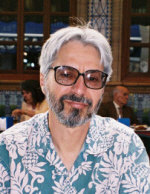 Barry Spector writes about American history and politics from the perspective of mythology and archetypal psychology. He is seeking a publisher for his book, Madness At The Gates Of The City: The Myth Of American Innocence. Barry is a regular performer at Great Night of Soul poetry events in the San Francisco Bay Area. He and his wife Maya present Oral Traditions Salons and facilitate an annual "Day of the Dead" grief ritual. Bay Area readers are encouraged to email him at shmoover@comcast.net to get on his mailing list for these events. Barry runs a furniture moving company, but he would rather move your soul.
Barry Spector writes about American history and politics from the perspective of mythology and archetypal psychology. He is seeking a publisher for his book, Madness At The Gates Of The City: The Myth Of American Innocence. Barry is a regular performer at Great Night of Soul poetry events in the San Francisco Bay Area. He and his wife Maya present Oral Traditions Salons and facilitate an annual "Day of the Dead" grief ritual. Bay Area readers are encouraged to email him at shmoover@comcast.net to get on his mailing list for these events. Barry runs a furniture moving company, but he would rather move your soul.
Return to Mythic Passages Menu
Subscribe to the Mythic Passages e-magazine
|
